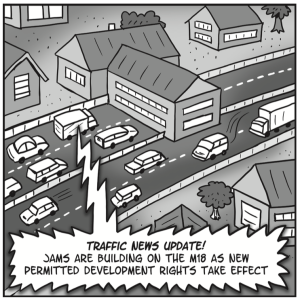Permitted development (PD) rights allow you to carry out certain types of development without the need to apply for planning permission. In England, they are set out in the General Permitted Development Order (the GPDO), legislation that grants planning permission in advance for various developments, subject to limitations.
Most of you will have heard of PD rights for domestic extensions – almost all householders in the country can extend to the front, side, rear, and on the roof without applying for permission. It is these rights that we will focus on in this article.

In recent years, there has also been a big increase in the PD rights available to property developers to change shops, offices, and other premises into residential units (mostly because the government doesn’t trust the mainstream planning system to deliver enough new homes fast enough). If you are interested in commercial PD rights, check out this article on Class MA rights to convert commercial premises into homes.
Broadly speaking, homeowners PD rights are much more generous than what might be achieved through mainstream planning. For example, you may get a much bigger extension under PD than under a full planning application. So, if you are thinking of extending your house, always start by exploring what you can do under PD!
But beware! permitted development is a minefield. Some houses don’t have PD rights at all (because they are listed buildings or in a conservation area, or because those rights were removed, for example).
Flats have almost no PD rights. And the limitations and conditions set out in the PD legislation can be difficult to interpret. Never, ever assume that what you are proposing is PD and that you may press ahead without a care – you are strongly advised to prepare plans and seek confirmation from the council that your plans meet the requirements of the GPDO by submitting an application for a certificate of lawfulness. If you are unsure, Ask Martin for some advice.
WHAT ARE THE MAIN PERMITTED DEVELOPMENT RIGHTS FOR HOMEOWNERS?
PD rights for England are set out in Schedule 2 of the GPDO. Householder extensions and alterations are covered by Part 1 of that Schedule. Different types of extensions are set out in categories: Class A relates to single-storey rear extensions; Class B to roof alterations and so on, as follows:
| Class A | covers the enlargement, improvement or alteration of a house, such as rear or side extensions, as well as general alterations, such as new windows and doors. |
| Class AA | covers the extension of a house upwards to add one or two extra storeys. |
| Class B | covers additions or alterations to roofs that enlarge the house, such as loft conversions involving dormer windows. |
| Class C | covers other alterations to roofs, such as re-roofing or the installation of roof lights/windows. |
| Class D | covers the erection of a porch outside an external door. |
| Class E | covers development within the curtilage of the house (mostly sheds and outbuildings). |
| Class F | covers the provision of hard surfaces within the curtilage of the house, such as driveways. |
| Class G | covers the installation, alteration or replacement of a chimney, flue or soil and vent pipe. |
| Class H | covers the installation, alteration or replacement of microwave antennae such as satellite dishes. |
As I have explained, the rights are not limitless – your extension is only PD if you meet the very specific criteria set out in the GPDO. Like all legislation, the GPDO is written in legalese and is therefore a little opaque, though if you read it slowly and carefully it is not as impenetrable as it first seems.
Helpfully, the government has published Technical Guidance to accompany the GPDO. This explains in simple language, and with use of diagrams, what is and is not permitted under the GPDO.
The government also has a helpful online resource, called the “interactive house” which allows you to interact with a representation of a typical house to see how it might typically be extended. Interacting with the “house” is like playing a computer game and is about as fun as the householder planning system gets.
WHAT SHOULD I DO IF I WANT TO TAKE ADVANTAGE OF PERMITTED DEVELOPMENT RIGHTS?
I always recommend that you apply to the council for a certificate of lawfulness as confirmation that what you are proposed is, in fact, permitted development.
A good architect of planning consultant will also be able to give you advice, and check out my book, How to Get Planning Permission, which has a detailed guide to the rights available.
For advice bespoke to your situation, don’t forget the Ask Martin service!

